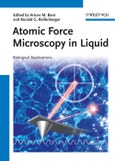About 40 % of current atomic force microscopy (AFM) research is performed in liquids, making liquid-based AFM a rapidly growing and
important tool for the study of biological materials. This book focuses on the underlying principles and experimental aspects of AFM under
liquid, with an easy-to-follow organization intended for new AFM scientists. The book also serves as an up-to-date review of new AFM techniques developed especially for biological samples.
Aimed at physicists, materials scientists, biologists, analytical chemists, and medicinal chemists. An ideal reference book for libraries.
From the contents:
Part I: General Atomic Force Microscopy
AFM: Basic Concepts
Carbon Nanotube Tips in Atomic Force Microscopy with
Applications to Imaging in Liquid
Force Spectroscopy
Atomic Force Microscopy in Liquid
Fundamentals of AFM Cantilever Dynamics in Liquid
Environments
Single-Molecule Force Spectroscopy
High-Speed AFM for Observing Dynamic Processes in Liquid
Integration of AFM with Optical Microscopy Techniques
Part II: Biological Applications
DNA and Protein-DNA Complexes
Single-Molecule Force Microscopy of Cellular Sensors
AFM-Based Single-Cell Force Spectroscopy
Nano-Surgical Manipulation of Living Cells with the AFM
important tool for the study of biological materials. This book focuses on the underlying principles and experimental aspects of AFM under
liquid, with an easy-to-follow organization intended for new AFM scientists. The book also serves as an up-to-date review of new AFM techniques developed especially for biological samples.
Aimed at physicists, materials scientists, biologists, analytical chemists, and medicinal chemists. An ideal reference book for libraries.
From the contents:
Part I: General Atomic Force Microscopy
AFM: Basic Concepts
Carbon Nanotube Tips in Atomic Force Microscopy with
Applications to Imaging in Liquid
Force Spectroscopy
Atomic Force Microscopy in Liquid
Fundamentals of AFM Cantilever Dynamics in Liquid
Environments
Single-Molecule Force Spectroscopy
High-Speed AFM for Observing Dynamic Processes in Liquid
Integration of AFM with Optical Microscopy Techniques
Part II: Biological Applications
DNA and Protein-DNA Complexes
Single-Molecule Force Microscopy of Cellular Sensors
AFM-Based Single-Cell Force Spectroscopy
Nano-Surgical Manipulation of Living Cells with the AFM
Table of Contents
PART I: General Atomic Force MicroscopyAFM: BASIC CONCEPTS
Atomic Force Microscope: Principles
Piezoelectric Scanners
Tips and Cantilevers
Force Detection Methods for Imaging in Liquids
AFM Operation Modes: Contact, Jumping/Pulsed, Dynamic
The Feedback Loop
Image Representation
Artifacts and Resolution Limits
CARBON NANOTUBE TIPS IN ATOMIC FORCE MICROSCOPY WITH APPLICATIONS TO IMAGING IN LIQUID
Introduction
Fabrication of CNT AFM Probes
Chemical Functionalization
Mechanical Properties of CNTs in Relation to AFM Applications
Dynamics of CNT Tips in Liquid
Performance and Resolution of CNT Tips in Liquid
FORCE SPECTROSCOPY
Introduction
Measurement of Force Curves
Measuring Surface Forces by the Surface Force Apparatus
Forces between Macroscopic Bodies
Theory of DLVO Forces between Two Surfaces
Van der Waals Forces - the Hamaker Constant
Electrostatic Force between Surfaces in a Liquid
Spatially Resolved Force Spectroscopy
Force Spectroscopy Imaging of Single DNA Molecules
Solvation Forces
Hydrophobic Forces
Steric Forces
Conclusive Remarks
DYNAMIC-MODE AFM IN LIQUID
Introduction
Operation Principles
Instrumentation
Quantitative Force Measurements
High-Resolution Imaging
Summary and Future Prospects
FUNDAMENTALS OF AFM CANTILEVER DYNAMICS IN LIQUID ENVIRONMENTS
Introduction
Review of Fundamentals of Cantilever Oscillation
Hydrodynamics of Cantilevers in Liquids
Methods of Dynamic Excitation
Dynamics of Cantilevers Interacting with Samples in Liquids
Outlook
SINGLE-MOLECULE FORCE SPECTROSCOPY
Introduction
AFM-SMFS Principles
Dynamics of Adhesion Bonds
Specific versus Other Interactions
Steered Molecular Dynamics Simulations
Biological Findings Using AFM-SMFS
Concluding Remarks
HIGH-SPEED AFM FOR OBSERVING DYNAMIC PROCESSES IN LIQUID
Introduction
Theoretical Derivation of Imaging Rate and Feedback Bandwidth
Techniques Realizing High-Speed Bio-AFM
Substrate Surfaces
Imaging of Dynamic Molecular Processes
Future Prospects of High-Speed AFM
Conclusion
INTEGRATION OF AFM WITH OPTICAL MICROSCOPY TECHNIQUES
Introduction
Combining AFM and IRM-TIRF
Combining AFM and FRET
FRET-AFM
Sample Preparation and Experiment Setup
PART II: Biological Applications
AFM IMAGING IN LIQUID OF DNA AND PROTEIN-DNA COMPLEXES
Overview: the Study of DNA at Nanoscale Resolution
Sample Preparation for AFM Imaging of DNA and Protein-DNA Complexes
AFM of DNA in Aqueous Solutions
AFM Imaging of Alternative DNA Conformations
Dynamics of Protein -
DNA Interactions
DNA Condensation
Conclusions
STABILITY OF LIPID BILAYERS AS MODEL MEMBRANES: ATOMIC FORCE MICROSCOPY AND SPECTROSCOPY APPROACH
Biological Membranes
Mechanical Characterization of Lipid Membranes
Future Perspectives
SINGLE-MOLECULE ATOMIC FORCE MICROSCOPY OF CELLULAR SENSORS
Introduction
Methods
Probing Single Yeast Sensors in Live Cells
Conclusions
A FM-BASED SINGLE-CELL FORCE SPECTROSCOPY
Introduction
Cantilever Choice
Cantilever Functionalization
Cantilever Calibration
Cell Attachment to the AFM Cantilever
Recording a Force -
Distance Curve
Processing F -
D Curves
Quantifying Overall Cell Adhesion by SCFS
SFCS with Single-Molecule Resolution
Dynamic Force Spectroscopy
Measuring Cell -
Cell Adhesion
Conclusions and Outlook
NANOSURGICAL MANIPULATION OF LIVING CELLS WITH THE AFM
Introduction: Mechanical Manipulation of Living Cells
Basic Mechanical Properties of Proteins and Cells
Hole Formation on the Cell Membrane
Extraction of mRNA from Living Cells
DNA Delivery and Gene Expression
Mechanical Manipulation of Intracellular SFs
Cellular Adaptation to Local Stresses
Application of Carbon Nanotube Needles
Use of Fabricated AFM Probes with a Hooking Function
Membrane Protein Extraction
Future Prospects








